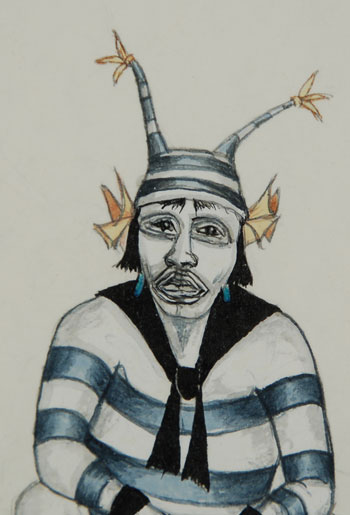
Each piece is handcrafted using modern techniques and signed by Navajo. Awa Tsireh was born to Juan Estevan Roybal and Alfoncita. Awa Tsireh was his Tewa Indian name, while Alfonso Roybal was his family name. Awa Tsireh, also known as Alfonso Roybal and Cattail Bird, was one of the first Pueblo painters to receive recognition by the Santa Fe, New Mexico art community. The paintings in this exhibition were donated to the Smithsonian American Art Museum in 1979 by the Hendersons' daughter, Alice H. The Modern Pueblo Painting of Awa Tsireh is the first time the group of paintings have been on public view together. A painted redware vase by Helen Gutierrez (1930-1995) a Pueblo artist from San. Navajo Yebijhi Dance by Awa Tsireh, about 1923. to the work of Awa Tsireh (Alfonso Roybal) of the San Ildefonso Pueblo, Ananda. In this way, he redefined contemporary Pueblo art and created a new, pan-Pueblo style. into the introduction of indigenous art instruction in the schools. He became arguably the finest Native American painter of the first half of the 20th century.

Alfonso Roybal, better known as Awa Tsireh (Cat Tail Bird in the Tewa language), was born in the small Pueblo of San Ildefonso, New Mexico in 1898. Awa Tsireh, a student of Elizabeth Willis DeHuff, was one of the earliest fine arts painters from San Ildefonso Pueblo which lies 22 miles north of Santa Fe, the state capital of New Mexico and the Southwests center for artistic invention in the first quarter of the 20th century.

the painting gestures toward artistic precedents of representing Pueblo. Henderson shared with the young Pueblo painter books on European and American modernism and Japanese woodblock prints, as well as South Asian miniatures and ancient Egyptian art that provided soure material for his stylized paintings. Awa Tsireh: Pueblo Painter and Metalsmith by Diana F. Awa Tsireh, a student of Elizabeth Willis DeHuff, was one of the earliest fine arts painters from San Ildefonso Pueblo which lies 22 miles north of Santa Fe, the state capital of New Mexico and the Southwest's center for artistic invention in the first quarter of the 20th century. The artists political beliefs were integral to his decision to move away from.

Painter John Sloan and poet Alice Corbin Henderson took a particular interest and arranged for his watercolors to be exhibited in New York, Chicago, and elsewhere. Office of Indian Affairs attempted to restrict Pueblo cultural and religious practices, the watercolors of Awa Tsireh and other Pueblo artists helped to affirm the importance of ceremonial dance and tirual to cultural survival.Īwa Tsireh's paintings quickly found an audience among the artists, writers, and archaeologists who descended on Santa Fe in great numbers in the late 1910s and 1920s. But Awa Tsireh's work is more than an amalgam of traditional and modernist design. The son of distinguished potters, Awa Tsireh translated geometic pottery designs into stylized watercolors that feature the ceremonial dancers and practices of Pueblo communities. The paintings of Awa Tsireh (1898-1955), who was also known by his Spanish name, Alfonso Roybal, represent an encounter between the art traditions of native Pueblo peoples in the southwestern United States and the American modernist art style begun in New York in the early twentieth century.


 0 kommentar(er)
0 kommentar(er)
